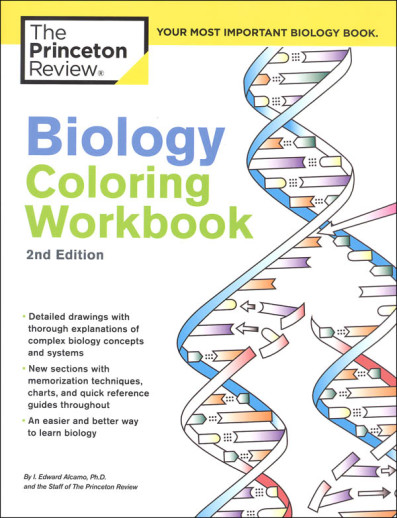We use cookies to make your experience better. To comply with the new e-Privacy directive, we need to ask for your consent to set the cookies. Learn more.
Biology Coloring Workbook 2nd ed. (Princeton Review)
Just to confuse the people in our warehouse, we've decided to add another Biology Coloring Workbook to our catalog. Actually, we couldn't decide between the two. This one is from The Princeton Review and covers a lot of the same material as the HarperCollins edition. They both contain textual information on one page and a coloring page on the other. They both help students to affix the concepts of biology in mind, through coloring as they learn. The other one suggests specific colors for structures. This one makes less particular demands, often just asking you to use a "light color," "dark color," or "bold color," giving the artist in you more flexibility. On the pro side, I have found that the presentation of topics in this book corresponds much more closely to the presentation of topics in our biology books. Basic chapters are: Introduction to Biology, Biology of the Cell, Principles of Genetics, DNA and Gene Expression, Principles of Evolution, The Origin of Life and Simple Life Forms, Biology of Plants, Biology of Animals, Human Biology, Reproduction and Development, and Principles of Ecology. Colored pencils or felt-tip pens are recommended. 156 plates. Contains evolutionary content.
The Biology Coloring Workbook, 2nd Edition uses the act of coloring to provide you with a clear and concise understanding of biological structures.Learning interactively through coloring fixes biological concepts in the mind and promotes quick recall on exams. It's aless frustrating, more efficient way to learn than rotememorization from textbooks or lecture notes!
An invaluable resource for students of biology, anatomy, nursing & nutrition, medicine, physiology, psychology, art, and more, theBiology Coloring Workbookincludes:
156 detailed coloring plates withclear and precise artwork
Comprehensive, thorough explanations of each of the depicted topics
Coloring suggestions for each lesson, with labels for easy identification and reference
New sections with memorization techniques, helpful charts, and quick reference guides
The Biology Coloring Workbook follows the standard organization of introductory textbooks, with plates organized into the following sections:
Introduction to Biology
Biology of the Cell
Principles of Genetics
DNA and Gene Expression
Principles of Evolution
The Origin of Life and Simple Life Forms
Biology of Plants
Biology of Animals
Human Biology
Reproduction and Development in Humans
Principles of Ecology
| Product Format: | Softcover Book |
|---|---|
| Brand: | Princeton Review |
| Author: | I. Edward Alcamo |
| Grades: | PK-AD |
| ISBN: | 9780451487780 |
| Length in Inches: | 10.875 |
| Width in Inches: | 8.375 |
| Height in Inches: | 0.8125 |
| Weight in Pounds: | 2.3 |

